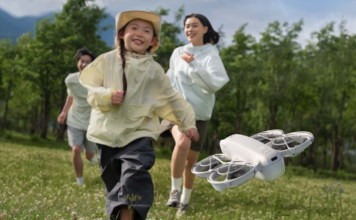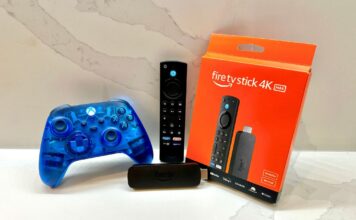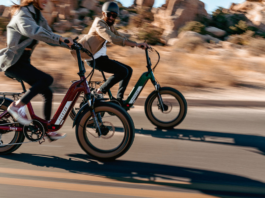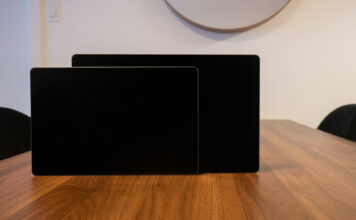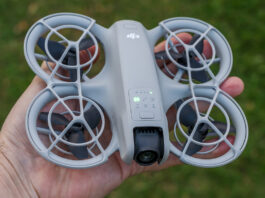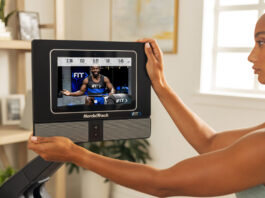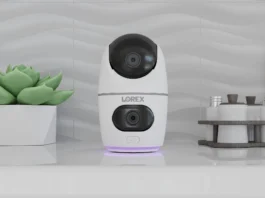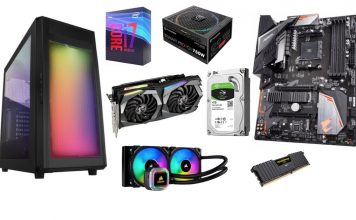 Drones are a fun way to pass the time, especially as we head into the summer months and warm weather. Whether you’re interested in a smaller quad-copter, or something a bit more serious, it’s always neat to take one for a spin around the neighborhood and turn a few heads in the process. Today, we’re going to look at the more serious side of drone piloting as I review one of the more high end products: the DJI Phantom 2 Vision Plus.
Drones are a fun way to pass the time, especially as we head into the summer months and warm weather. Whether you’re interested in a smaller quad-copter, or something a bit more serious, it’s always neat to take one for a spin around the neighborhood and turn a few heads in the process. Today, we’re going to look at the more serious side of drone piloting as I review one of the more high end products: the DJI Phantom 2 Vision Plus.
Up until now, there weren’t really a lot of options out there for drones that let you record and fly. In fact, you’d usually have to resort to a GoPro strapped to a drone.
That all changes with this and its included camera and recording system.
Before you head out and begin your filming quest, there are a few things that you should remember. First of all, you must be 18 to legally pilot one of these drones. While the Phantom is a larger drone, it does not require an additional license.
There are a few more things you must keep in mind as well, such as what are and aren’t no fly areas. Here’s a Beginner’s Guide to Drones to get you started on learning the ins and outs to safe flight
The DJI Phantom 2 Vision Plus is a drone in a class of its own, touting itself as the world’s first aerial filmmaking system available to everyone (not just the movie studios!) In fact, the onboard camera can capture video for up to 80% of the Phantom’s entire battery meaning that you’ll have ample time to get your drone up in the air, center your shots and begin filming. This 14 MP camera already comes connected to the Drone to make it easier for you to get a quick start in the air. The camera’s success relies on a 3-axis gimbal system that gives your filming stability throughout and helps to correct your (well, my) poor piloting skills while in flight. No matter which crazy directions you accidentally fly your way into, the gimbal keeps the camera steady and on course.

Out of the box, the Vision Plus looks like this:
- The Unit itself
- The Radio Transmitter
- Propellers
- Batteries for the transmitter
- An accessory kit which includes rubber dampers (to keep the camera focused and still) and extra parts.
- Charger kit and Micro USB cable (more on that later.)
One thing I found interesting was that the package’s charger kit also included voltage converters which allow you to take your Phantom 2 worldwide. While the system has a traditional North American 120v/60hz attached for things out of the box, should you end up taking it overseas, the box also has voltage plugins for Australia and the UK.
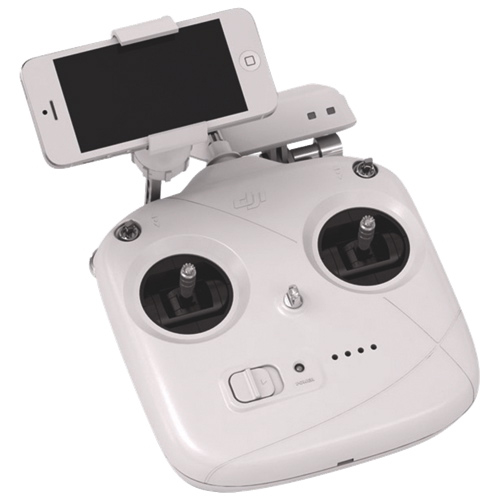 Lastly, there is also a Quick Start kit to get you up and flying right away. Within that kit is a manual, a step by step guide for the basics (including connecting your smartphone to the camera and how to connect the props.) 2 sets of decals, and more.
Lastly, there is also a Quick Start kit to get you up and flying right away. Within that kit is a manual, a step by step guide for the basics (including connecting your smartphone to the camera and how to connect the props.) 2 sets of decals, and more.
The radio transmitter is large and feels a bit bulky, but it’s definitely got some power to it, including an onboard WiFi range extender which allows you to connect your smartphone to the camera and have it show you video from up to 2000 feet away (or just over 0.6 KM) It also has a little smartphone cradle to mount and see a live feed from your camera, as well as getting easy access to the camera’s controls itself. There are 2 apps you can download from your respective device’s app store (iOS or Android) that can control filming or still photography. I would really just stick with the DJI Vision App since it’s all encompassing, and comes with clear instructions on how to get started. One thing to keep in mind here is that the radio transmitter itself runs on AA batteries, but the WiFi Range Extender needs to be charged separately. That can be done with the Micro USB cable and attaching it to your computer.
Once you have the unit out of the box and charged, getting it going is pretty easy. There are two sets of propellers included, and they are colour coded to the adjoining bolts you can put them on. The props must be spun a certain way to tighten, but once they are hand spun, leave them as they will finish tightening themselves once you start the engine.
On one hand, it’s unusual to see two sets of props included with something like this. After all, DJI does also sell Prop guards for beginner pilots which look to keep the propellers safe from harm. On the other hand, if you don’t install the prop guards, one rough landing or close tree encounter means you can chew up one or two of the propellers in an instant.
Once this is done, I’d say the next step is just to power everything on and make sure it works. Once you’ve confirmed, it’s a very easy next step to sync up your smartphone and the Phantom 2 Vision Plus. All you have to do is locate the WiFi network it puts forth and it basically syncs up automatically. Be sure to have created a profile with DJI for the Phantom Vision app, and log in to start accessing the album and camera features when you get going.
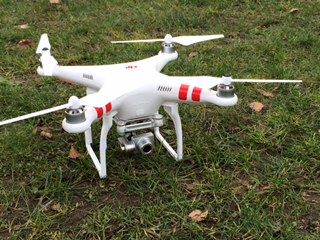 When you power the unit on for the first time, you’re probably going to be faced with a “Compass error” message of some point. Be sure to pull the gimbal cover and lens cap off, by the way, or else you’ll get those error messages to. In my case, the error stated that the compass error needed maintenance. In my mind, I had automatically thought and was hoping that it wasn’t broken out of the box. This isn’t actually the case. You actually need to align the compass every time you take your Phantom to a new flying area.
When you power the unit on for the first time, you’re probably going to be faced with a “Compass error” message of some point. Be sure to pull the gimbal cover and lens cap off, by the way, or else you’ll get those error messages to. In my case, the error stated that the compass error needed maintenance. In my mind, I had automatically thought and was hoping that it wasn’t broken out of the box. This isn’t actually the case. You actually need to align the compass every time you take your Phantom to a new flying area.
All I did to accomplish this was toggle the “S1” stick on the radio transmitter until the unit’s LED lights flashed yellow. Then, I spun the Phantom in two 360 patterns slowly – Once horizontally, and once vertically. The lights will flash again and then go back to the regular color changing pattern. You’ll also know you’re successful, obviously, when the error message goes away on the app.
Taking it out for a flight is pretty simple. You just face the control sticks on the transmitter at the bottom most corner facing each other, and the unit powers on. Here, you also have to let go of both of them simultaneously once you unit IS powered on, and then it should stay on. I had a little bit of trouble keeping the unit powered, but got it eventually. Here is where I would recommend that beginners turn their video on since you can obviously make edits if you need to later on. The unit comes with a removable 4GB MicroSD card, however, you can upgrade that to up to 32 GB if you need to. Video records at an approximate file size of around 2.2 MPBS, meaning that standard 4 GB card nets you about 30 minutes of video. It should be noted here that the maximum length you can take a video for is 20 minutes. I did mention earlier that this was 80% of the battery life, ergo, the DJI Phantom 2 Vision Plus can fly for up to 25 minutes. If you’re curious about battery life at anytime, you can see it visually in one of two places – The drone itself features a 4 bar battery on the back of the unit (1 for each 25%) and will fade and flash depending on how life is left (the instruction manual has a full legend.) If you are up in the air, however, the DJI Vision App keeps track on a digital scale of how much battery life is left and very audibly begins to warn you when it reaches 20% or less. One other quick thing I should mention is that you CAN feasibly fly this without using mounting your smartphone and directing that way, however, I wouldn’t recommend it if only because you have no other way of knowing how much battery life is left on main unit, and having it drop out of the sky on you with a dead battery is too expensive of a lesson to learn.
Regarding your video recording, you should be aware that there is no audio. This was surprising to me at first, but then I realized 90% of what you would be catching are the prop engines, and as such, it would probably drown out anything you had thought you could capture. There are videos online of people who have added things to their drone in order to catch audio, and as you can expect, it just sounds like an F1 race overlayed with the video footage.
When you’ve got the unit in the air, you’ll notice that it handles like a charm. With all of the drones I’ve been fortunate to review over the years here for Best Buy’s Plug In Blog, this one is the heaviest by far, yet most nimble in the air. One of the worst control troubles I’ve experienced in the past with flying drones is the amount of pull from the slightest flick on the transmitter which sends the craft on a collision course, careening into objects. I had no such trouble here. The DJI unit flew and landed perfectly on all runs, and while I had trouble trying to figure out the advanced features on this drone, like its GPS lock (allowing for easier landing,) I didn’t need it at any point.

If you’re a fairly adventurous drone pilot, and want to push this thing to its limits as far away as possible from you, the drone does have a failsafe program in which it will return its way back to you if it’s out of range. This isn’t really a feature I ever would have thought up for something like this, but it’s definitely a huge convenience for sure.
Just a couple last quick things: if you’re having trouble with the configuration or calibration of the unit at any point (including the compass troubles I mentioned earlier,) there is a program for your PC and Mac available from DJI. Dubbed “The Assistant,” you plug the drone into your computer via Micro USB and it can help you diagnose and problem solve.
Unfortunately, hooking up to the PC was oddly the one thing I couldn’t do and couldn’t get figured out. I seem to be in the minority judging by many owners online, but it might be because I’m running Windows 8.1 and it may be better suited for XP or 7 (the Assistant program, however, loaded up just fine.) In order for me to pull my videos off the memory card, I ended up having to stick the MicroSD card into a reader and pulling them down that way.
The DJI Phantom 2 Vision Plus is a very impressive machine out of the box, and I would recommend it to any serious drone enthusiast who wants to get into the higher end market. While DJI provides you with everything you need to get going with, you can still make upgrades if you need to. For example, if you own a GoPro, you can purchase a different gimbal system to be able to run your recordings with that instead. You can even buy additional accessories like a car charger to juice your device up on the go instead of having to do it at home all the time. Lastly, replacement parts of pretty well everything are available, from the landing gear to any mounting brackets that might break in the course of your flying (or rough landings.)
The DJI Phantom 2 Vision Plus Drone is now available online only at BestBuy.ca



